Reverse Offset Printed, Biocompatible Temperature Sensor Based on Dark Muscovado
Abstract
:1. Introduction
2. Materials and Methods
2.1. Materials
2.2. Experimental
2.2.1. Sensor Fabrication
2.2.2. Film Surface Morphology and Compositional Characterization
2.2.3. Electrical Characterization
3. Results and Discussion
4. Conclusions
Author Contributions
Funding
Institutional Review Board Statement
Informed Consent Statement
Data Availability Statement
Conflicts of Interest
References
- Adamek, M.; Matyas, J.; Adamkova, A.; Mlcek, J.; Buran, M.; Cernekova, M.; Sevcikova, V.; Zvonkova, M.; Slobodian, P.; Olejnik, R. A Study on the Applicability of Thermodynamic Sensors in Fermentation Processes in Selected Foods. Sensors 2022, 22, 1997. [Google Scholar] [CrossRef] [PubMed]
- Shahid, A. Fabrication and Characterization of Printed Sensors Based on Nano-Composite Materials. Ph.D. Thesis, Jeju National University, Jeju Island, Korea, 2017. [Google Scholar]
- Aziz, S.; Chang, S.-H. Smart-fabric sensor composed of single-walled carbon nanotubes containing binary polymer composites for health monitoring. Compos. Sci. Technol. 2018, 163, 1–9. [Google Scholar] [CrossRef]
- Aziz, S.; Zaman, U.K.U.; Mazhar, A.R.; Ali, J.; Jung, D.W. Development of Reciprocating Inkjet System for Printed Electronic Devices. Procedia CIRP 2022, 107, 920–924. [Google Scholar] [CrossRef]
- Baek, S.; Kim, J.; Pujar, P.; Kwon, H.; Kim, S.; Gandla, S. Sub-Zero Temperature Sensor Based on Laser-Written Carbon. Adv. Electron. Mater. 2022, 8, 2101252. [Google Scholar] [CrossRef]
- Chen, L.; Yao, X.; Liu, X.; Luo, Z.; Ye, C.; Huang, C.; Wang, C.; Cai, C.; Lyu, L.; Wu, X.; et al. High Throughput In–Situ Temperature Sensor Array with High Sensitivity and Excellent Linearity for Wireless Body Temperature Monitoring. Small Struct. 2022, 3, 2200080. [Google Scholar] [CrossRef]
- Coblentz Society, Inc. Sucrose. COBLENTZ NO. 3335. 1963. Available online: https://webbook.nist.gov/cgi/cbook.cgi?ID=C57501&Type=IR-SPEC&Index=0 (accessed on 12 September 2022).
- Cui, Y.; Gao, P.; Tang, W.; Mo, G.; Yin, J. Adaptive Thin Film Temperature Sensor for Bearing’s Rolling Elements Temperature Measurement. Sensors 2022, 22, 2838. [Google Scholar] [CrossRef]
- Kim, M.K.; Kantarcigil, C.; Kim, B.; Baruah, R.K.; Maity, S.; Park, Y.; Kim, K.; Lee, S.; Malandraki, J.B.; Avlani, S.; et al. Flexible submental sensor patch with remote monitoring controls for management of oropharyngeal swallowing disorders. Sci. Adv. 2019, 5, eaay3210. [Google Scholar] [CrossRef] [Green Version]
- Kojima, C.; Xia, H.; Yamamoto, Y.; Shiigi, H. Front Cover: A Naked-eye Colorimetric pH and Temperature Sensor Based on Gold Nanoparticle-Loaded Stimuli-Sensitive Dendrimers (ChemNanoMat 3/2022). ChemNanoMat 2022, 8, e202100442. [Google Scholar] [CrossRef]
- Landari, H.; Roudjane, M.; Messaddeq, Y.; Miled, A. Pseudo-Continuous Flow FTIR System for Glucose, Fructose and Sucrose Identification in Mid-IR Range. Micromachines 2018, 9, 517. [Google Scholar] [CrossRef] [Green Version]
- Lee, Y.S.; Son, M.; Zhbanov, A.; Jung, Y.; Jung, M.H.; Eom, K.; Nam, S.H.; Park, J.; Yang, S. Temperature Correction to Enhance Blood Glucose Monitoring Accuracy Using Electrical Impedance Spectroscopy. Sensors 2020, 20, 6231. [Google Scholar] [CrossRef]
- Leng, T.; Parvez, K.; Pan, K.; Ali, J.; McManus, D.; Novoselov, K.S.; Casiraghi, C.; Hu, Z. Printed graphene/WS2 battery-free wireless photosensor on papers. 2D Mater 2020, 7, 024004. [Google Scholar] [CrossRef]
- Li, Q.; Liu, S.; Wang, J.; Mbola, N.M.; Meng, Z.; Wang, X.; Xue, M. A biocompatible, self-adhesive, and stretchable photonic crystal sensor for underwater motion detection. J. Mater. Chem. C 2022, 10, 9025–9034. [Google Scholar] [CrossRef]
- Liu, L.; Meng, X.; Zhang, C.; Chen, Y.; Sun, T.; Lu, Z.; Zhang, J.; Niu, S.; Han, Z.; Duan, J.A. A Multifunctional Flexible Sensor with Coupling Bionic Microstructures Inspired by Nature. J. Mater. Chem. C 2022, 10, 11296–11306. [Google Scholar] [CrossRef]
- Al Mamun, A.; Yuce, M.R. Recent Progress in Nanomaterial Enabled Chemical Sensors for Wearable Environmental Monitoring Applications. Adv. Funct. Mater. 2020, 30, 2005703. [Google Scholar] [CrossRef]
- Mulla, R.; Dunnill, C.W. Sensors-on-paper: Fabrication of graphite thermal sensor arrays on cellulose paper for large area temperature mapping. HardwareX 2021, 11, e00252. [Google Scholar] [CrossRef]
- Ryu, S.; Yoo, I.; Song, S.; Yoon, B.; Kim, J.-M. A Thermoresponsive Fluorogenic Conjugated Polymer for a Temperature Sensor in Microfluidic Devices. J. Am. Chem. Soc. 2009, 131, 3800–3801. [Google Scholar] [CrossRef]
- Sahoo, S.; Parashar, S.K.S.; Ali, S.M. CaTiO3 nano ceramic for NTCR thermistor based sensor application. J. Adv. Ceram. 2014, 3, 117–124. [Google Scholar] [CrossRef] [Green Version]
- Sang, M.; Kang, K.; Zhang, Y.; Zhang, H.; Kim, K.; Cho, M.; Shin, J.; Hong, J.; Kim, T.; Lee, S.K.; et al. Ultrahigh Sensitive Au-Doped Silicon Nanomembrane Based Wearable Sensor Arrays for Continuous Skin Temperature Monitoring with High Precision. Adv. Mater. 2021, 34, 2105865. [Google Scholar] [CrossRef]
- Song, S.; Jung, A.; Hong, S.; Oh, K. Strain-Insensitive Biocompatible Temperature Sensor Based on DNA Solid Film on an Optical Microfiber. IEEE Photon. Technol. Lett. 2019, 31, 1925–1928. [Google Scholar] [CrossRef]
- Strümpler, R. Polymer composite thermistors for temperature and current sensors. J. Appl. Phys. 1996, 80, 6091–6096. [Google Scholar] [CrossRef]
- Sun, J.; Li, Y.; Liu, G.; Chen, S.; Zhang, Y.; Chen, C.; Chu, F.; Song, Y. Fabricating High-Resolution Metal Pattern with Inkjet Printed Water-Soluble Sacrificial Layer. ACS Appl. Mater. Interfaces 2020, 12, 22108–22114. [Google Scholar] [CrossRef] [PubMed]
- Sun, J.; Li, Y.; Liu, G.; Chu, F.; Chen, C.; Zhang, Y.; Tian, H.; Song, Y. Patterning a Superhydrophobic Area on a Facile Fabricated Superhydrophilic Layer Based on an Inkjet-Printed Water-Soluble Polymer Template. Langmuir 2020, 36, 9952–9959. [Google Scholar] [CrossRef] [PubMed]
- Sun, J.; Sun, R.; Jia, P.; Ma, M.; Song, Y. Fabricating flexible conductive structures by printing techniques and printable conductive materials. J. Mater. Chem. C 2022, 10, 9441–9464. [Google Scholar] [CrossRef]
- Vandana; Gupta, R.; Tandon, R.P.; Tomar, M. Enhanced Pyroelectric Coefficient in Ferroelectric Lead Zirconium Titanate Thick Films for Thermal Energy Harvesting Applications. ECS J. Solid State Sci. Technol. 2022, 11, 023015. [Google Scholar] [CrossRef]
- Ji, W.; Wang, H.B.; Miao, L.M.; Guo, H.; Chen, H.T.; Cheng, X.L.; Zhang, H.X. An Active Temperature Sensor Based on Encapsulated Flexible and Transparent Triboelectric Nanogenerator. In Proceedings of the 14th Annual IEEE International Conference on Nano/Micro Engineered and Molecular Systems, NEMS 2019, Bangkok, Thailand, 11–14 April 2019; pp. 229–232. [Google Scholar] [CrossRef]
- Wu, S.; Yu, J.; Zhang, K.; Yang, J.; Zhang, S.; Xing, J.; Liu, C.; Deng, Y. Ultrawide Range and High-precision Temperature Monitoring based on NiO/Polyimide Hybrid Nanomaterials. ChemNanoMat 2022, 8, e202100496. [Google Scholar] [CrossRef]
- Xing, H.; Guo, M.; Zhang, L.; Zhang, Y. The Humidity Compensation for Temperature Sensor Based on Improved SPSO-BP Neural Network. Chin. J. Sens. Actuators 2018, 31, 380–385. [Google Scholar] [CrossRef]
- Xu, W.; Wong, M.C.; Hao, J. Strategies and progress on improving robustness and reliability of triboelectric nanogenerators. Nano Energy 2019, 55, 203–215. [Google Scholar] [CrossRef]
- Yuvaraja, S.; Nawaz, A.; Liu, Q.; Dubal, D.; Surya, S.G.; Salama, K.N.; Sonar, P. Organic field-effect transistor-based flexible sensors. Chem. Soc. Rev. 2020, 49, 3423–3460. [Google Scholar] [CrossRef]
- Zhao, Z.; Li, Q.; Dong, Y.; Gong, J.; Li, Z.; Zhang, J. Washable Patches with Gold Nanowires/Textiles in Wearable Sensors for Health Monitoring. ACS Appl. Mater. Interfaces 2022, 14, 18884–18900. [Google Scholar] [CrossRef]
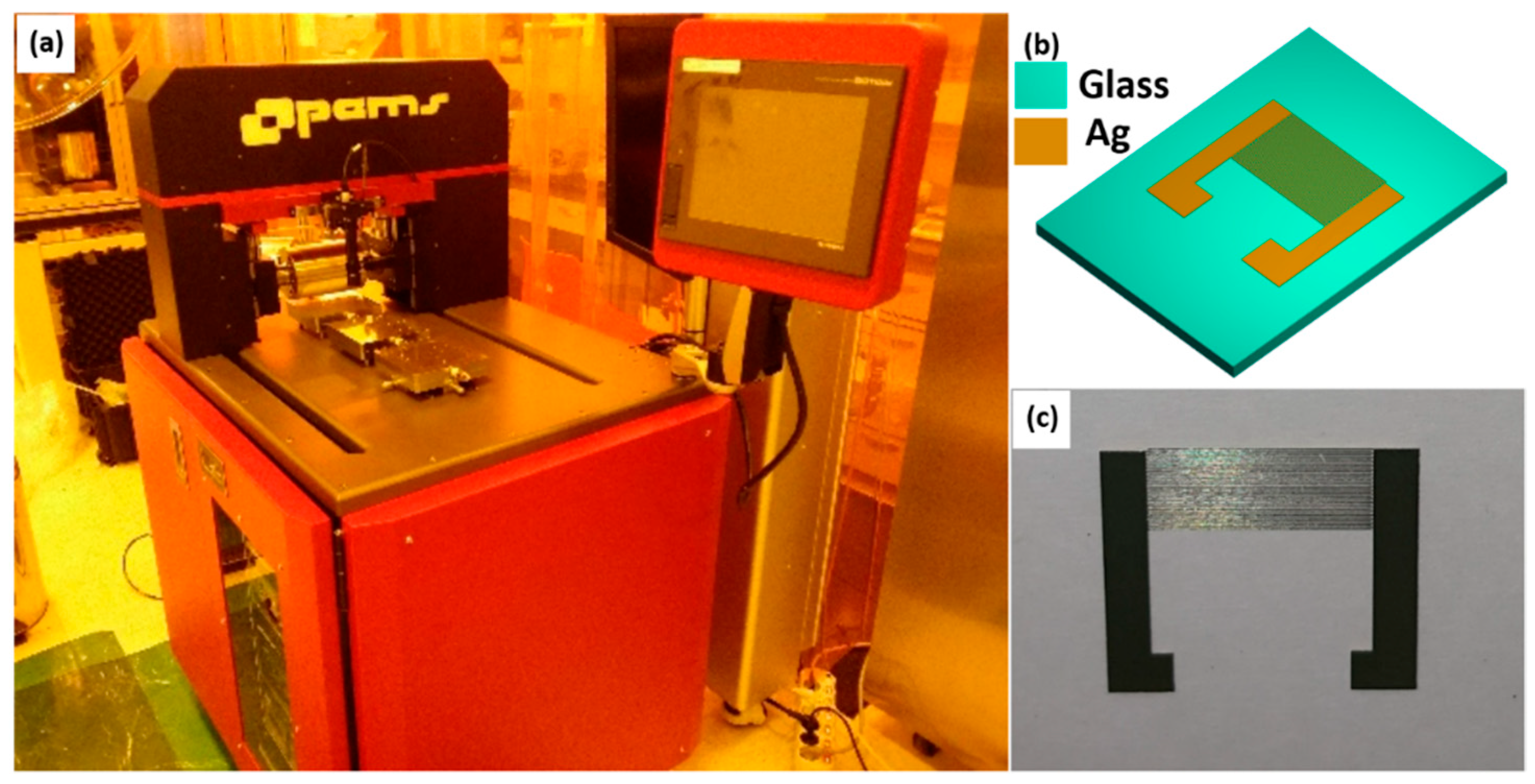
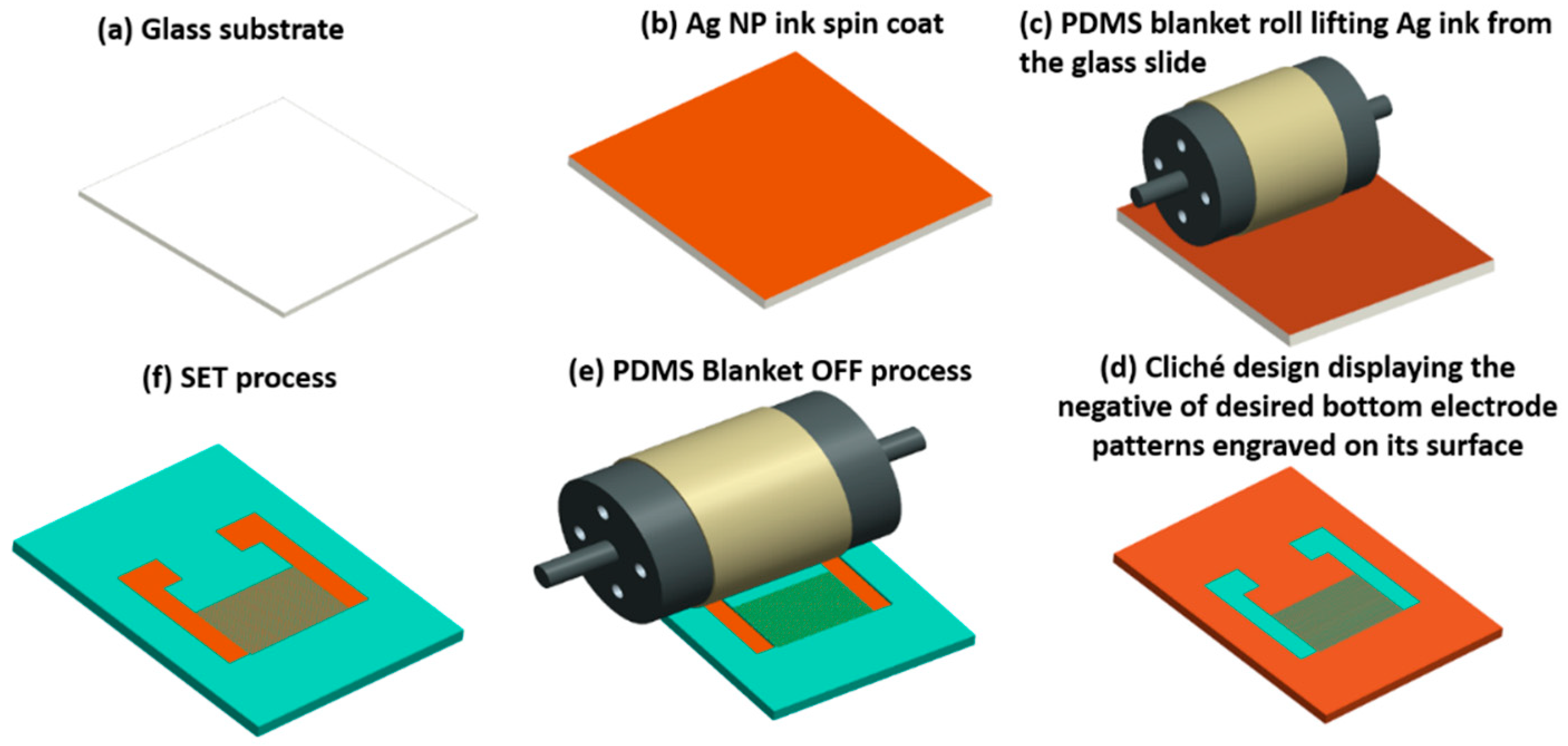
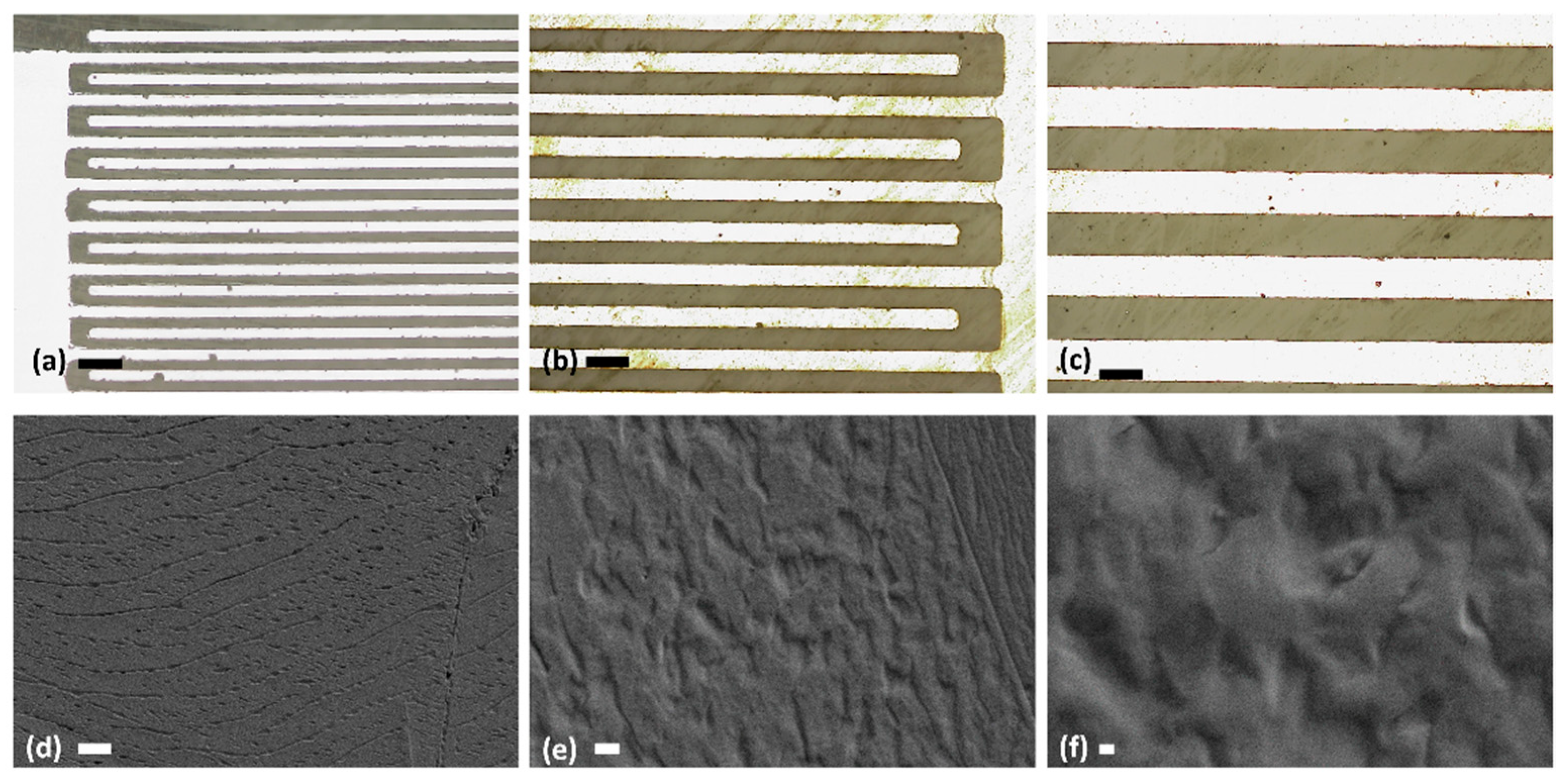
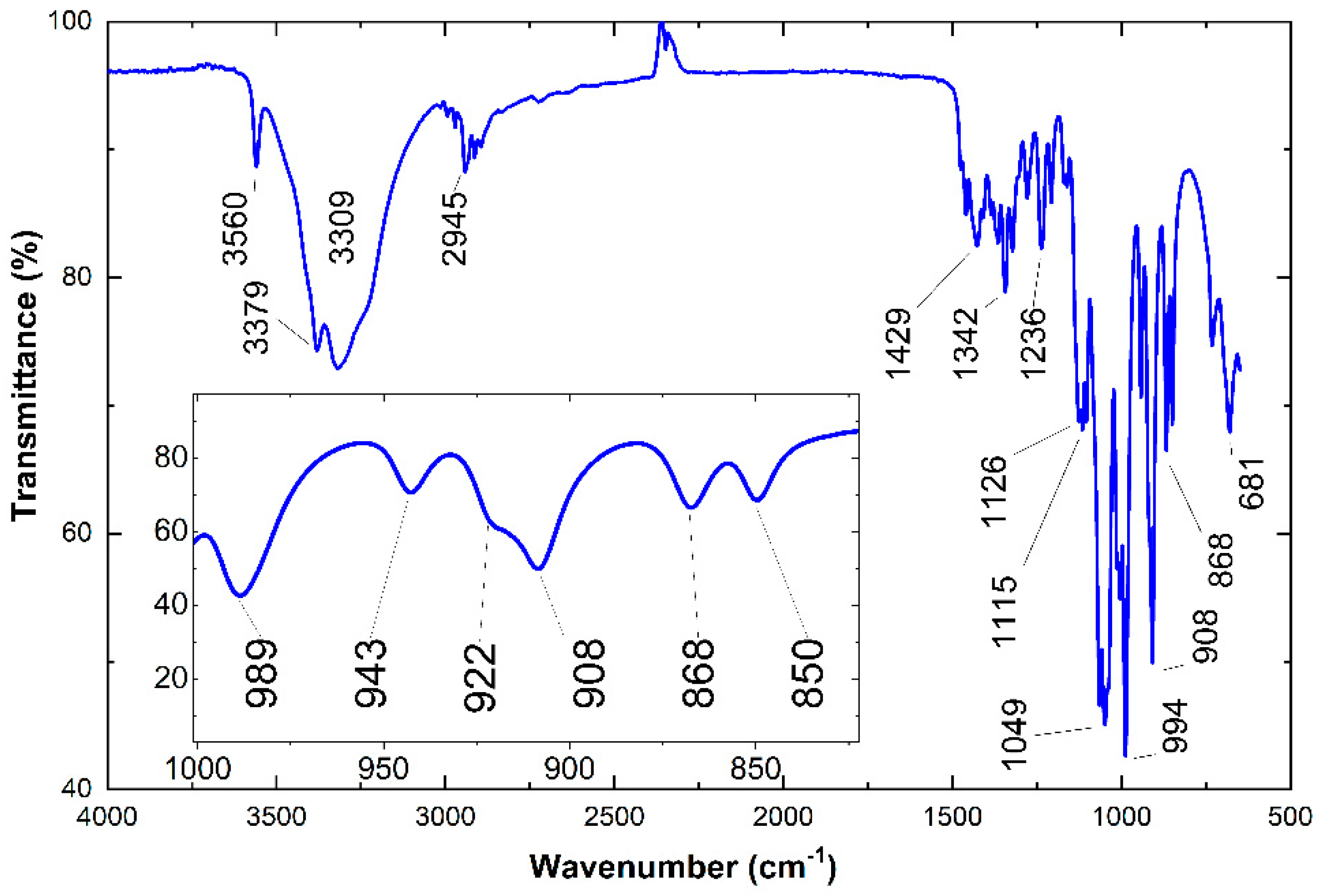


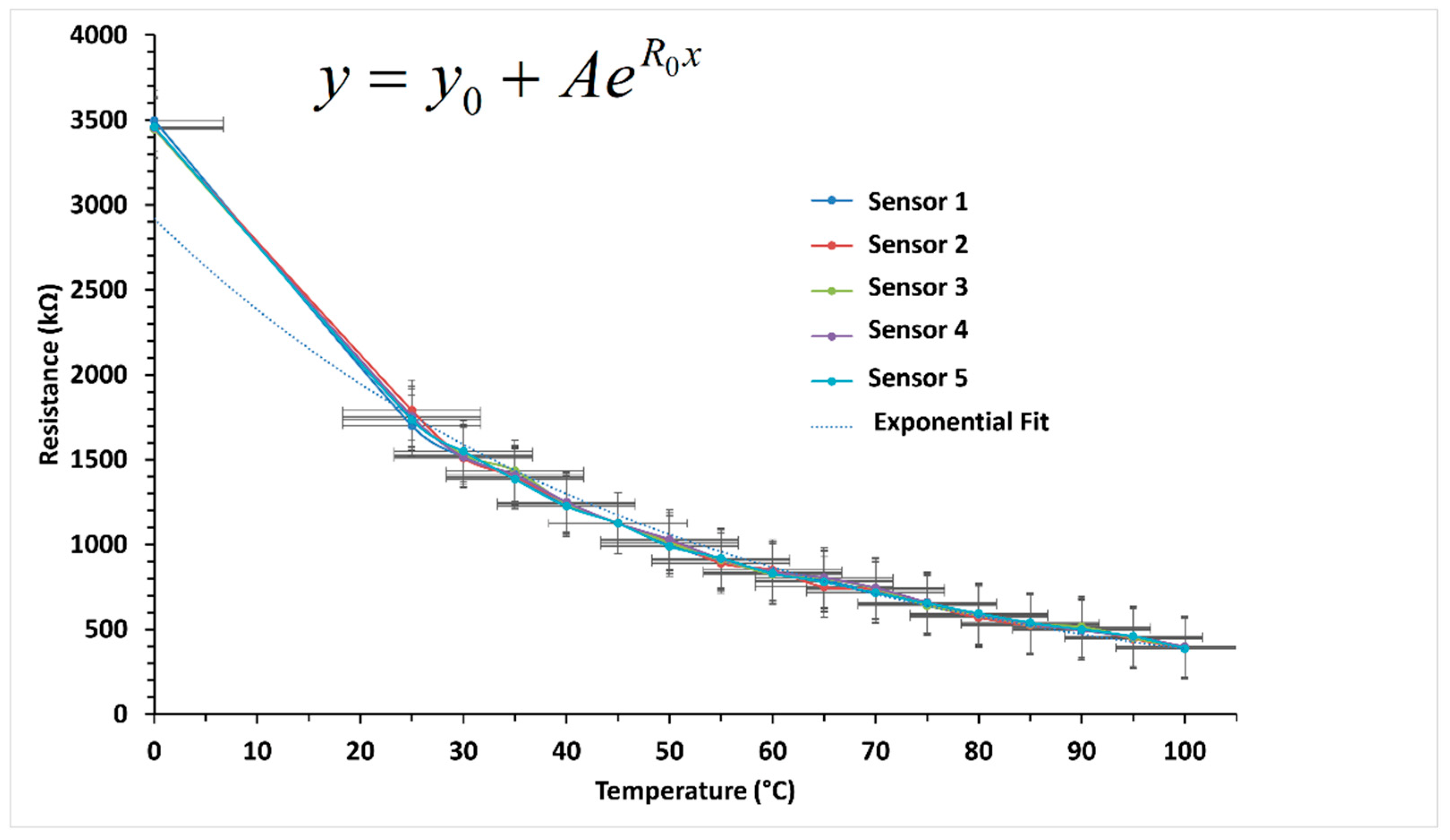

| Peak Position (cm−1) | Reported Peak Positions (cm−1) | Position Error (cm−1) |
|---|---|---|
| 833 | 834 | 1 |
| 865 | 869 | 4 |
| 920 | 924 | 4 |
| 996 | 994 | 2 |
Publisher’s Note: MDPI stays neutral with regard to jurisdictional claims in published maps and institutional affiliations. |
© 2022 by the authors. Licensee MDPI, Basel, Switzerland. This article is an open access article distributed under the terms and conditions of the Creative Commons Attribution (CC BY) license (https://creativecommons.org/licenses/by/4.0/).
Share and Cite
Aziz, S.; Ali, J.; Bhandari, K.S.; Chen, W.; Li, S.; Jung, D.W. Reverse Offset Printed, Biocompatible Temperature Sensor Based on Dark Muscovado. Sensors 2022, 22, 8726. https://doi.org/10.3390/s22228726
Aziz S, Ali J, Bhandari KS, Chen W, Li S, Jung DW. Reverse Offset Printed, Biocompatible Temperature Sensor Based on Dark Muscovado. Sensors. 2022; 22(22):8726. https://doi.org/10.3390/s22228726
Chicago/Turabian StyleAziz, Shahid, Junaid Ali, Krishna Singh Bhandari, Wenning Chen, Sijia Li, and Dong Won Jung. 2022. "Reverse Offset Printed, Biocompatible Temperature Sensor Based on Dark Muscovado" Sensors 22, no. 22: 8726. https://doi.org/10.3390/s22228726
APA StyleAziz, S., Ali, J., Bhandari, K. S., Chen, W., Li, S., & Jung, D. W. (2022). Reverse Offset Printed, Biocompatible Temperature Sensor Based on Dark Muscovado. Sensors, 22(22), 8726. https://doi.org/10.3390/s22228726










